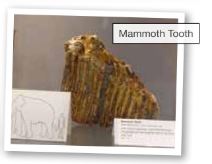- Home
- Local History
- From Mammoths Teeth to the Tudor: A History of Orpington
From Mammoth's Teeth to the Tudor: A Romp Through the History of Orpington
Written by Pam Preedy.
On 15th December, 1922, the Bromley and District Times announced that a Mammoth’s tooth, about five feet long, had been discovered in a gravel pit at Green-Street-Green. It seems quite amazing that mammoths were roaming over our local landscape until the end of the Ice Age over 12,000 years ago.
Perhaps early people living in Orpington would go out to hunt one of these huge mammals, or an early species of rhinoceros and hippopotamus. Throughout human history people must have lived in the area, usually in isolated family groups. Evidence of their occupation has been found from the first flint implements such as ‘the Pounder’, a piece of flint similar in shape and size to a cricket ball, and the ‘pot-boiler’ rather like the ‘pounder.’ The pounder was heated in the fire and dropped into water to heat it.

Remains found in Orpington give clues to the progress of British history. Evidence of Roman occupation abounds in the area; Roman coins and pottery, the Crofton roman Villa near Orpington, Caesars Well at Keston.
After the Romans came the Saxons dating back about 1,500 years ago. It is thought that Orpington owed its origin to a Saxon family or clan. The Saxon ‘ing’ meant ‘the son of.’ ‘Ton’ or ‘tun’ originally meant a place surrounded by a hedge; a homestead or farm. therefore Orpington means the homestead of the family or clan or Orp.
The Danes left left traces in the name of Bexley (Danish ‘beck’ or brook). Eadsy, a priest, treasurer to King Canute and later Archbishop of Canterbury, purchased land in Orpington in 1032 and gave it to the Monks of Christ Church in Canterbury.
The Norman Conquest changed everything: Odo, Bishop of Bayeux and half-brother of William the conqueror was allotted the Earldom of Kent and seized many manors including Orpington, His ownership did not last long and it was recovered for the Church by Archbishop Lanfranc.
Orpington appears in the Domesday Survey (1080) showing ten acres of meadow, 5 dens of wood sufficient for 50 hogs and worth in 1080 twenty-five pounds. A further entry relates to the Manor of Mayvil or Mayfield, which stood in the area around the Walnuts Centre. The Priory was first mentioned in 1270, and records show additions to the house in 1393 and in the 17th century.

Orpington continued to survive through the Wars of the Roses and the religious upheavals under Tudors; Henry VIII, in his desire to marry Anne Boleyn, changed the religion of the country to protestant. Mary I reverted back to Catholicism. Elizabeth I, a protestant, had been threatened by her cousin Mary Queen of Scots and Spain. Then there was the English Civil War (1642-1651), the beheading of Charles I and finally, the Restoration of Charles II in 1660 following the puritanical rule of Oliver Cromwell’s Commonwealth.
Men and women of Orpington may have had to make worrying decisions that could affect their safety and the safety of their families. Perhaps they just went about their own business, keeping their heads down trying to keep out of harm’s way. There was bound to be gossip and speculation.
Which religion did you support? Would you support the Roundheads or the Cavaliers? While there is little evidence of events of national importance happening in Bromley, the people would have had to face the national challenges to daily living as we do today.

A visit to the Bromley Historic Collections in the Bromley Library Museum is well worth a visit.
Originally published in Life in Bromley magazine (Issue 37, March 2022)
